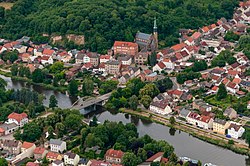Oderberg
Oderberg | |
|---|---|
 Aerial view of the town center | |
Location of Oderberg within Barnim district  | |
| Coordinates: 52°52′00″N 14°03′00″E / 52.86667°N 14.05000°E | |
| Country | Germany |
| State | Brandenburg |
| District | Barnim |
| Municipal assoc. | Britz-Chorin-Oderberg |
| Government | |
| • Mayor (2019–24) | Martina Hähnel[1] |
| Area | |
• Total | 35.31 km2 (13.63 sq mi) |
| Elevation | 5 m (16 ft) |
| Population (2022-12-31)[2] | |
• Total | 2,143 |
| • Density | 61/km2 (160/sq mi) |
| Time zone | UTC+01:00 (CET) |
| • Summer (DST) | UTC+02:00 (CEST) |
| Postal codes | 16248 |
| Dialling codes | 033369 |
| Vehicle registration | BAR |
| Website | www |
Oderberg (German: [ˈoːdɐbɛʁk] ) is a town in the district of Barnim, in Brandenburg in northeastern Germany. It is situated 16 km east of Eberswalde, and 27 km southwest of Schwedt, close to the border with Poland, and in close vicinity of Berlin.
Overview
The territory has many lakes, remnants from the ice age. The area is widely used for outdoor recreation, such as biking, walking and boating. As Biosphere region it is home to many species of wildlife. Oderberg is closest to the Oder river crossing leading directly to Cedynia, Poland.
History
From 1815 to 1947, Oderberg was part of the Prussian Province of Brandenburg, from 1947 to 1952 of the State of Brandenburg, from 1952 to 1990 of the East German Bezirk Frankfurt and since 1990 again of Brandenburg.
Demography

|
|
|
Gallery
-
Town hall
-
Church in Neuendorf
-
Saint Nicholas church
-
Museum
References
- ^ Landkreis Barnim Wahl der Bürgermeisterin / des Bürgermeisters, accessed 30 June 2021.
- ^ "Bevölkerungsentwicklung und Bevölkerungsstandim Land Brandenburg Dezember 2022" (PDF). Amt für Statistik Berlin-Brandenburg (in German). June 2023.
- ^ Detailed data sources are to be found in the Wikimedia Commons.Population Projection Brandenburg at Wikimedia Commons








